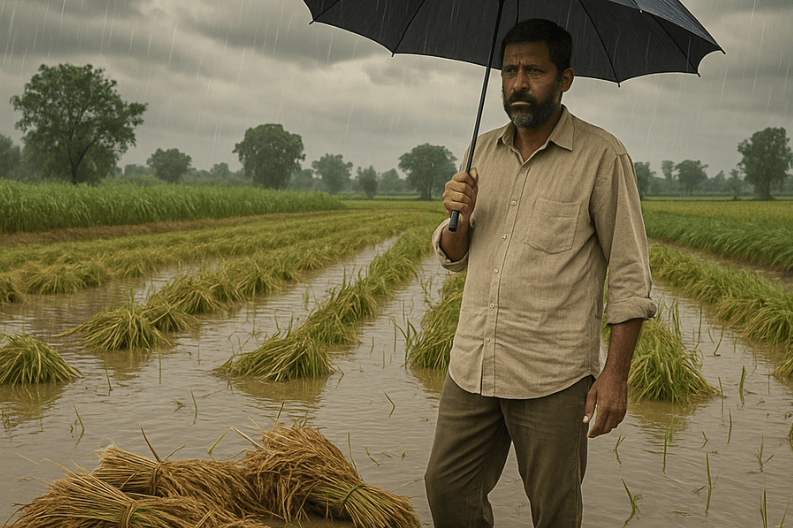Daily News
Understanding the Unseasonal Rains in North India
This October, farmers in North India faced heavy unseasonal rains that disrupted their harvest.

The unseasonal rains in North India this October have left thousands of farmers struggling to save their crops. Just as they were preparing for a successful harvest, heavy rains returned unexpectedly. This sudden change has caused stress among farmers and raised new concerns about shifting weather patterns in the region.
Experts from the India Meteorological Department (IMD) explained that a strong Western Disturbance caused the recent rainfall. This weather system usually forms over the Mediterranean Sea and moves toward India during winter, bringing rain and snow. However, meteorologists have observed that these disturbances are now appearing more frequently, even outside their normal season. October, which was once a dry month, is now seeing unusual rainfall patterns.
According to the IMD, monsoon behavior has changed over the years. The department recently revised the normal monsoon withdrawal date in West Rajasthan from September 1 to September 17. This means the rainy season now extends longer than it did decades ago. Experts say that the traditional four-month monsoon period often stretches into mid or late October, showing clear signs of climate change.
Farmers across Punjab, Haryana, and Delhi have been hit hardest. After dealing with monsoon floods earlier this year, they were ready to begin harvesting rice, maize, and sugarcane. Unfortunately, the unexpected downpour soaked their fields again. Many farmers had to rush through harvesting to prevent further loss. This quick harvest may lead to poor-quality grains, lowering their income.
In addition to crop damage, the rains also brought a noticeable drop in temperature. Delhi recorded a fall of 7 to 9 degrees Celsius, creating an early winter-like chill. Meanwhile, Jammu and Kashmir and Himachal Pradesh experienced snow in areas such as Gulmarg and Pahalgam, where temperatures dipped below freezing.
Although the rain has now reduced, the IMD warned that more precipitation may occur later this month. October is traditionally a dry month, but recent years have shown a different trend. For instance, last year, India experienced four low-pressure systems in October, including one that developed into the severe cyclonic storm Dana. This year, another system from the Arabian Sea turned into a strong cyclone named Shakhti, further worsening the weather situation.
Scientists are linking these changes to rising global temperatures. Data from IMD shows that October 2024 recorded a mean temperature 1.23°C higher than normal, making it the warmest October since 1901. Interestingly, four of the five hottest Octobers ever recorded—2015, 2017, 2020, and 2024—have occurred within the last decade. These trends reflect the growing influence of global warming on regional weather.
Such erratic weather patterns are becoming a major challenge for the agriculture sector. Farmers depend on predictable rainfall and stable temperatures to plan their sowing and harvesting. The changing climate, however, makes their work riskier and threatens food security for millions. Agricultural experts are urging the government to strengthen crop insurance schemes and improve weather prediction systems to help farmers adapt.
Furthermore, scientists recommend promoting climate-resilient crops such as millets and pulses, which can withstand temperature fluctuations and irregular rain. Improving irrigation systems and soil management can also reduce losses during unexpected weather events.
In conclusion, the unseasonal rains in North India have revealed the growing effects of climate change on agriculture. Farmers hope for clear skies ahead, but experts warn that such unusual weather may become more common in the future. Better planning, awareness, and sustainable farming practices will be key to coping with these shifting patterns.
Daily News
UAE Visa Ban Pakistan: Rising Rejections Leave Travelers Stranded

The UAE visa ban Pakistan has intensified as Pakistani citizens face unprecedented challenges obtaining travel permits to the Gulf nation. Additional Interior Secretary Salman Chaudhry revealed Thursday that the UAE has stopped issuing visas to most Pakistani passport holders, though no formal ban exists.
Currently, the UAE only processes visas for blue and diplomatic passport holders. Blue passports are reserved for government officials, while ordinary citizens carry green passports. Senator Samina Mumtaz Zehri confirmed that authorities linked these restrictions to concerns about travelers “getting involved in criminal activities.”
Travel agents report alarming statistics. First-time and single-entry visa applications for Dubai now face rejection rates between 70 to 80 percent. Consequently, many Pakistani travelers find themselves in limbo despite having legitimate travel plans.
The UAE has stopped issuing most visas to Pakistani citizens amid concerns over criminal activity. The suspension affects tourist, visit, and work visas, though current visa holders remain unaffected.
Officials warn that a full ban could follow if the situation does not improve.… pic.twitter.com/rsCAZ7xEnR— India Today Global (@ITGGlobal) November 27, 2025
Saher Nazeer from Visa Express Karachi explained that applicants with family ties in the UAE have better approval chances. Meanwhile, single visa applications see only 20 percent acceptance rates. Furthermore, family visas achieve approximately 80 percent approval.
Twenty-eight-year-old Nadeem from Lahore experienced rejection twice this year. First in January, then again in November. His travel agency blamed his age, stating that applicants “under 40” face higher scrutiny. Despite being employed full-time and providing bank statements, his applications failed.
“I don’t understand it. What does my age have to do with anything? My friend, a freelancer, got it on the first attempt,” Nadeem told reporters. He has since applied a third time, hoping for different results.
Similarly, sports journalist Muzamil Asif couldn’t cover the Asia Cup in Dubai after rejection. Despite having proper accreditation and documentation, his visa failed because he was “a single man under 35.” His news outlet lost nearly Rs 100,000 on cancelled bookings.
Travel agents cite strict financial criteria as major rejection factors. Ubaid Sajjad from AEG-Visa stated that applicants need six-month bank statements showing approximately Rs 3 million for better chances. Additionally, insufficient funds remain the primary reason for single visa rejections.
Moreover, Quratulain from Premio Travel & Tours highlighted that previous overstaying and unclear financial documentation cause many rejections. These stringent requirements create significant barriers for ordinary Pakistani citizens.
Overseas Employment Promoter Aisam Baig explained that UAE authorities worry about Pakistanis on visit visas potentially “resorting to begging.” In January 2025, the Senate Standing Committee learned that officials had ‘unofficially closed’ some UAE visas for this reason.
Furthermore, Pakistan’s former UAE ambassador Faisal Niaz Tirmizi described the situation as “serious and significant.” He noted that Emirati authorities raised concerns about document authenticity, including educational credentials. Even genuine documents with improper attestation trigger rejections.
Timeline of Events
| Month | Development |
|---|---|
| January 2025 | Senate informed that UAE visas are “unofficially closed.” |
| February 2025 | Ambassador calls visa refusal “a serious issue.” |
| April 2025 | UAE announces visa issues resolved |
| July 2025 | Interior Minister raises concerns again |
| November 2025 | Full passport ban revealed as consideration |
In April, UAE Ambassador Hamad Obaid Ibrahim Salem Al-Zaabi announced that the UAE and Pakistan resolved the visa issues. Pakistanis could now avail five-year visas, he stated. However, problems persisted despite these assurances.
Subsequently, Interior Minister Mohsin Naqvi raised the issue with his UAE counterpart in July. During a meeting, UAE Lt Gen Sheikh Saif bin Zayed Al Nahyan assured full support in expediting visas. Nevertheless, travelers continued facing obstacles.
Interestingly, the same Thursday that the ban on revelations emerged, UAE Ambassador Salem M. Salem Al Bawab Al Zaabi briefed Finance Minister Muhammad Aurangzeb on visa facilitation reforms. These include online processing, e-visas without passport stamping, and faster digital linkages.
According to official statements, nearly 500 visas are processed daily at the newly launched UAE Visa Centre in Pakistan. Additionally, the UAE embassy established three biometric desks, ensuring transparency in applications.
The UAE hosts 2.27 million Pakistani residents who can sponsor families under new laws. Moreover, the Gulf nation serves as Pakistan’s major trading partner in the Middle East and a key remittance source. Over 800,000 Pakistanis apply for Gulf country visas annually.
A senior UAE embassy diplomat dismissed speculation, stating, “There is no ban on UAE visas for Pakistani citizens.” He explained that some Pakistani travel agents had tampered with applicant data previously, leading to a centralized visa system.
The uncertainty creates significant financial and emotional stress. A tech entrepreneur from Karachi lost $550 (Rs 155,000) despite eventual approval. Journalist Fatima Attarwala faced double rejection despite corporate sponsorship for a major Dubai event.
Social media discussions reveal widespread frustration. Reddit users describe blocked transit visas and contradictory messages from agencies. Some users report an effective “ban on visit visas for Pakistanis in Dubai.”
In conclusion, the UAE visa ban Pakistan situation remains fluid despite diplomatic assurances. Travelers face mounting difficulties navigating opaque processes while authorities work toward solutions, balancing security concerns with bilateral relationships.
Daily News
Adelaide Weather: Showers and Cool Temperatures Continue Through Weekend

Adelaide weather continues to show unpredictable patterns as the city experiences a mix of cool conditions, showers, and occasional thunderstorms. The Bureau of Meteorology reports that a weak ridge of high pressure is moving east. Meanwhile, a low-pressure system brings unsettled conditions across South Australia.
Today, residents can expect showers beginning late morning. Additionally, thunderstorms may develop during the afternoon and evening hours. The maximum temperature will reach around 24 degrees Celsius. Furthermore, moderate winds will blow from the southwest, shifting direction later in the day.
.@AmeliaMulcahy7 has the latest 7-day weather forecast from Victoria Park. Send your weather videos and photos to 7NEWS Adelaide: https://t.co/xdDzDd1frA pic.twitter.com/oyLEDLyLqE
— 7NEWS Adelaide (@7NewsAdelaide) November 28, 2025
Looking ahead to the weekend, temperatures will dip slightly. Saturday brings a minimum of 13 degrees and a maximum of 20 degrees. Moreover, a few showers will occur throughout the day, particularly at night when rainfall chances increase significantly. Winds will maintain steady southwesterly speeds between 20 to 30 kilometers per hour.
Sunday follows a similar pattern with temperatures ranging from 12 to 21 degrees. Consequently, residents should prepare for occasional showers throughout the day. Monday continues this cooler trend with temperatures between 12 and 19 degrees and sporadic showers expected.
The Bureau has issued several important warnings. Firstly, a sheep grazier’s warning affects the Mount Lofty Ranges, Kangaroo Island, and the South East districts. Cold, showery, and windy conditions increase risks to vulnerable livestock. Therefore, farmers must take precautions to protect lambs and sheep.
Additionally, marine wind warnings cover multiple coastal areas. Strong winds affect Adelaide Metropolitan Waters, the Far West Coast, and several other regions. Consequently, marine enthusiasts and operators should exercise caution when navigating these waters.
Interestingly, while southern regions face cool conditions, the North East Pastoral District experiences severe heatwave conditions. Residents and travelers in that region should stay hydrated, limit outdoor activities, and seek cool environments.
The AUSX Adelaide Grand Final also felt the impact of inclement weather. Rainfall emerged after qualifying sessions, prompting organizers to postpone remaining events. Consequently, qualifying and heat races will now take place today instead.
Event director Adam Bailey explained the decision. He noted the three-day program allows flexibility to ensure optimal conditions. Moreover, the Protraxx team has maintained the track in prime condition, and organizers prefer not to damage it unnecessarily through muddy conditions.
Looking further ahead, Tuesday should bring some relief. Partly cloudy skies and a maximum of 21 degrees offer a break from showers. Subsequently, Wednesday promises sunny conditions with temperatures climbing to 28 degrees. Thursday will be even warmer, reaching 31 degrees with partly cloudy skies.
Throughout this period, rainfall amounts will vary. Most areas will receive moderate precipitation. However, isolated areas may experience heavier rains, particularly where thunderstorms develop. Therefore, residents should stay informed about weather updates.
In conclusion, Adelaide weather remains unsettled through the weekend with cooler temperatures and regular showers. Residents should plan outdoor activities accordingly and heed Bureau warnings. For the latest updates, visit the official Bureau of Meteorology website regularly.
Daily News
Meesho IPO GMP Shows Strong 29.7% Premium Ahead of December Launch

Meesho IPO GMP currently shows strong investor interest with unlisted shares trading at Rs 144, reflecting a grey market premium of Rs 33 or 29.7% over the upper price band. The SoftBank-backed e-commerce platform will launch its initial public offering on December 3, 2025.
The company has set a price band between Rs 105 and Rs 111 per share. The three-day subscription period will conclude on December 5. Meanwhile, anchor investors can place their bids one day earlier, on December 2.
#Meesho CMD & CEO @viditaatrey talks about the success of content creator programme ahead of #IPO
“50,000 influencers are making consistent income on #Meesho,” he says. @PoddarNisha @Meesho_Official pic.twitter.com/uoPoTOVieq
— NDTV Profit (@NDTVProfitIndia) November 28, 2025
Issue Size and Structure: The total issue aims to raise Rs 5,421.20 crore. This includes a fresh issue of Rs 4,250 crore and an offer for sale of 105.5 million shares worth Rs 1,171.20 crore. Several major investors will sell their stakes under the OFS.
Existing shareholders participating in the offer for sale include Elevation Capital V, Peak XV Partners Investments V, and Y Combinator Continuity Holdings. Additionally, promoters Vidit Aatrey, Sanjeev Kumar, and Man Hay Tam are also offloading their stakes. Notably, SoftBank will not sell any shares in this IPO.
Key Dates and Timeline
| Event |
Date |
| Anchor Bidding | December 2, 2025 |
| IPO Opening | December 3, 2025 |
| IPO Closing | December 5, 2025 |
| Basis of Allotment | December 8, 2025 |
| Refund Initiation | December 9, 2025 |
| Credit to Demat | December 9, 2025 |
| Listing Date | December 10, 2025 |
Investment Requirements: A single lot consists of 135 shares. Consequently, retail investors need a minimum investment of Rs 14,985 at the upper price band. The company has reserved 10% for retail investors, 15% for non-institutional investors, and 75% for qualified institutional buyers.
The company plans strategic utilization of fresh issue proceeds:
- Rs 1,390 crore for cloud infrastructure investment in subsidiary MTPL
- Rs 480 crore for salaries of Machine Learning and AI technology teams
- Rs 1,020 crore for marketing and brand initiatives
- Remaining funds for acquisitions and general corporate purposes
Company Overview
Meesho operates as India’s largest e-commerce marketplace based on placed orders and annual transacting users. During the twelve months ending September 2025, the platform served 23.42 crore annual transacting users. Impressively, 20.58 crore users came from outside the top eight cities.
Furthermore, women comprise 53.27% of Meesho’s user base. The platform’s value-driven model emphasizes affordability and accessibility. This reflects in declining average order values alongside surging placed orders reaching 183 crore.
Financial Performance: The company’s financial journey shows interesting trends:
| Fiscal Year | Revenue (Rs Cr) | Revenue (Rs Cr) |
Margin (%) |
| FY 2023 | 5,734.52 | (1,671.90) | (29.16) |
| FY 2024 | 7,615.15 | (327.64) | (4.30) |
| FY 2025 | 9,389.90 | (3,941.71) | (41.98) |
Platform Ecosystem: Meesho connects multiple stakeholders through its technology platform. Currently, 7,06,471 active sellers operate on the marketplace. Moreover, 18,098 logistics partners support delivery operations. Additionally, 50,319 content creators generate Rs 1,208 crore in net merchandise value through content commerce.
The company employs 2,082 people and operates across two segments-Marketplace and New Initiatives. It monetizes through fulfillment services, advertising, and data insights while maintaining a zero-commission policy for sellers.
Technology Infrastructure: The platform leverages AI and ML-powered systems for various functions. These include hyper-personalized recommendations, automated cataloguing, and logistics optimization. This modular, technology-first infrastructure enables low-cost, large-scale e-commerce penetration across India.
Market Position: India’s IPO market continues to break records in 2025. Total fundraising has crossed Rs 1.6 lakh crore, surpassing 2024’s Rs 1.59 lakh crore. Nearly half of this mobilization has occurred since September. Globally, India ranks fourth in IPO volumes this year.
Meesho seeks a valuation of up to Rs 5,01,000 crore ($5.6 billion) through this offering. Moreover, the company competes with Amazon and Walmart-owned Flipkart in India’s e-commerce space. However, Meesho particularly targets value-conscious customers in smaller cities.
Investment Considerations: The company raised Rs 268.5 crore from anchor investors before the public offering. Prominent participants included SBI Mutual Fund, ICICI Prudential MF, HDFC MF, and Nippon India MF. Insurance companies like SBI Life Insurance and Tata AIA Life Insurance also invested.
It’s important to note that the grey market premium is neither regulated by stock exchanges nor recommended by SEBI. Investors should conduct thorough research or consult financial experts before making investment decisions.
In conclusion, Meesho IPO GMP signals strong market sentiment ahead of listing. However, the combination of robust user metrics, an expanding ecosystem, and strategic growth plans positions the company for future development. So, investors can track allotment status through the KFin Technologies website starting December 8.
-

 Entertainment2 years ago
Entertainment2 years agoTop 15 Punjabi Models – Male and Female List
-

 City Guide3 years ago
City Guide3 years ago3B2 Mohali Market Shops: Discover 44 Hidden Gems
-

 Entertainment2 years ago
Entertainment2 years agoTop 11 Punjabi Comedians of All Time
-

 Jobs4 years ago
Jobs4 years agoTop 20 IT Companies in Mohali
-

 Food4 years ago
Food4 years ago11 Best Restaurants in Mohali You Must Visit
-

 Property2 years ago
Property2 years agoWho Lives In Homeland Mohali: Punjabi Celebrities, Business People…
-

 Food3 years ago
Food3 years agoTop 15 Cafes in Mohali you must visit
-

 Education2 years ago
Education2 years ago10 Famous Punjabi Writers With A Great Impact On The Literary World
